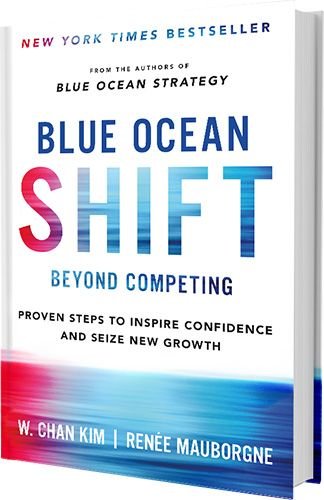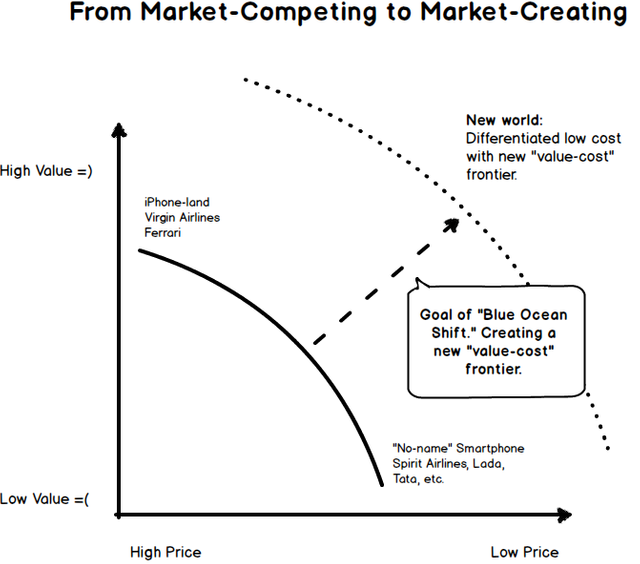The Blue Ocean Shift (Summary) - WHAT IS IT?

Source:(blueoceanstrategy.com)
The Blue Ocean Shift was authored and co-authored by W. Chan Kim and Renee Mauborgne. They believe that they have "proven steps to inspire confidence and seize new growth" for organisations in all industries.
Before I begin, the Blue Ocean Shift consists of two parts.
PART ONE: Blue Ocean Shift
PART TWO: The Five Steps to Making a Blue Ocean Shift
The Blue Ocean Shift has been recognized as one of the go-to books to read for any organisation or individual aiming to make a transition from the clustered and overcrowded market of their industry to a newly created market. The book also describes how companies have successfully used the Blue Ocean Strategy and managed to transition their company from "Red blooded oceans" to clear "Blue oceans".
To do this, the Blue Ocean Strategy shares a five step process for companies to dive into clearer blue oceans with more opportunities as to going through the more crowded competitive market. The five step process shows how small organizations such as Orchestras and big organizations such as government initiatives such as the Malaysian Government, has successfully implemented the Blue Ocean Strategy.
Instead of striving within the market-competing move, the Blue Ocean Strategy suggests that organizations should use market-creating moves to find and build new possibilities.
In order for organizations to be successful to a Blue Ocean Shift there are key components to this:
To adopt a blue ocean perspective, in order for you to expand your horizons and shift your understanding of new opportunities.
To have tools to guide the process of a blue ocean shift - these will help to translate a blue ocean perspective into new offerings.
To acquire and embrace the process of humanness approach - basically, this means to inspire and build people's self confidence, so that they can strive the process and successfully implement and transition into blue oceans.
According to the three key components of what sets an organization to transition from red oceans to blue oceans, we can view three concepts that support the above:
The Fundamentals of Market-Creating Strategy
There are many people who think that Market Creation needs to disrupt or involve a pinch of destruction on an industry. However, this is not the case. Yes, new technology usually disrupts old fashioned industries but they create new ones. Take a look at Sesame Street. Sesame Street created a whole new market targeting audiences for pre-school edutainment. This is categorized as a non-disruptive market creation.
In the Blue Ocean Shift, Market-Creating strategies can be in the form of the following three:
There can be a breakthrough solution for existing problems. - Cars increased the time and efficiency for people to get from point A to point B. This is usually a disruptive creation.
Identify and solve brand new issues and take advantage of new opportunities. - Ringtones were delivered into the market for people to express their individuality. Our growth indicates that solving a brand new problem, results in non-disruptive creation - "It grows profits, revenues and jobs".
There can be a redefinition of an industry problem and can be solved. - Cirque du Soleil (Circus) redefined the circus to be more family-oriented. Both disruptive and non-disruptive creations are possible.
People think that the key to unlocking market creation is through innovation and entrepreneurship.
The innovators of new technology can create extraordinary things, but to be able to convert these "things", requires a way of converting it into something of Value.
Blue Ocean Shifts happen when new Value-cost frontiers open up.

(Source: youexec.com)
The Mind of a Blue Ocean Mindset
Blue ocean strategists find ways to reshape industry conditions to be in their favour - This means that YOU need to think and imagine how you can change the industry. Allow your imaginations to flow!
Blue ocean strategists do not want to compete, instead they want to make competition irrelevant - Do not focus on creating competitive advantage. Instead, look for ways in which people value most!
Create and capture new customers, rather than fighting over existing ones - Organizations can do this by creating new demands.
Aim to do both differentiation and low cost - Those who use differentiation tend to focus on what to offer and those who go for low-cost tend to focus more on what to offer less.
Developing the Humanness, Confidence and Creative Competence
There are three main components to developing "Humanness" - (1) Atomization, (2) Firsthand Discovery, (3) Fair Process.
Humanness engages people emotionally and this brings out the confidence in people to be able to do what hey want to do. Once, they have the confidence they are able to use the tools and processes to be able to make a Blue Ocean transition.
Atomization
Atomization encourages organizations to break up the Blue Ocean process into smaller and easier tasks so that organizations can focus on smaller tasks and completing them better, rather than bigger and more complex tasks.
Firsthand Discovery
Allow people to make their own discoveries, this will allow people to imagine things they have never imagined before. This helps them to open up their mind to new things and new creativity.
Fair Process
There are three elements to this:
Engagement: Allow people to take part in strategic decision making. This allows employees to be able to feel respected and valued in the organization.
Explanation: This shows people that their opinions have been considered and it promotes trust between employees and managers.
Clear expectations: People can feel safe and respected if they know what their roles are, what their goals are and who is responsible for what.
When the organization chooses to implement the Fair Process, organizations may need to change their objectives in such a way that the organizational culture can shift to Blue Oceans.
This brings us to the end of PART ONE: The Blue Ocean Shift
Let me know your thoughts on this! I'd be happy to read feedbacks.
.png)
Your Upvotes, Comments and Follows are much appreciated!
#teammalaysia #steemit #steemit-help #steemitsuccess #steemit-success #steemitrockstars #steemit-rockstars #steemitrockstar #steemit-rockstar #steemit-tips #trending #new #steemittips #how-to-business #how-to-start-business #writer #blog #steemit-dolphins #steemit-success-tips #steemit-writing #steemittrending #steemit-tag #stemmitwhales #steemit-whales #succeed-on-steemit #kr #howtosucceedonsteemit #how-to-succeed-on-steemit #postpromotion #hot #hot-to #blue-ocean-shift-summary #summary #what-is-blue-ocean-shift
.png)